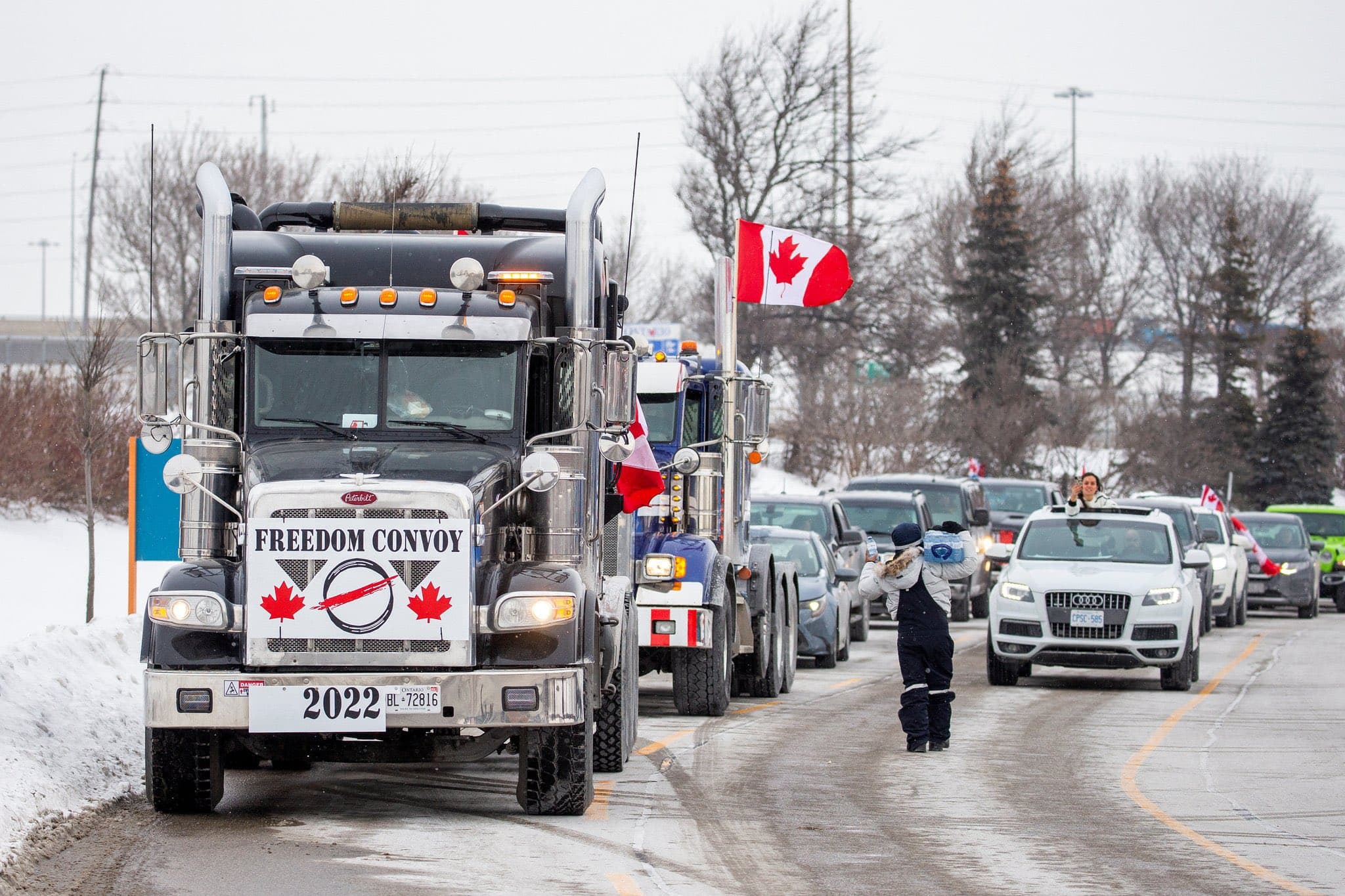
Last Saturday, thousands of Canadians braved the freezing weather, taking to the streets of their capital Ottawa in protest. They seek an immediate suspension of Prime Minister Justin Trudeau’s COVID-19 vaccine mandates. The main organizer was the Freedom Convoy, a large contingent of truckers whose vehicles now occupy the streets around Parliament Hill while they honk their horns, blocking all traffic. The truckers had come from all over Canada to converge on the city.
The idea for the movement was kindled after Trudeau’s November announcement that all Canadian truckers crossing the border from the U.S. needed to be vaccinated in order to avoid a 14-day quarantine. That mandate went into effect on January 15th, after which the movement, by then already grown in number, quickly gained steam.
While the peaceful protest was in full swing, Trudeau refused to engage in talks with the aggrieved. That Sunday, January 30th, he and his family were moved to a secret location over security concerns. The following day, the fully vaccinated and boosted Trudeau announced that he had tested positive for COVID-19 but was “feeling fine.” He said he would continue to work remotely that week while following public health guidelines. Trudeau dismissed the protesters, which he said constituted only a “small fringe minority” who do not represent the views of Canadians.
In a polarizing speech made that very day, Trudeau sought to depict all participants as people “who hurl abuse at small business workers and steal food from the homeless.” Referring to the presence of a Confederate flag during the protests, he said that “we won’t give in to those who fly racist flags,” and that “we won’t cave to those who engage in vandalism, or dishonor the memory of our veterans.” Such isolated instances, even if true, are hardly representative of the entire movement however; more likely, their mention is intended to serve as a distraction from the fact that Trudeau’s policy is fast losing support. Accusations of government infiltration quickly surfaced. For instance, some believed the individual who carried the Confederate flag to have been an agent provocateur, planted there to discredit the movement.
#FreedomConvoy protesters confronted a fully obscured & lone individual holding a confederate flag at the truckers’ protest in Ottawa. They believe he’s an outside provocateur. Similar incidents have happened in US involving leftists flying Nazi symbols. pic.twitter.com/irNVuJcjcd
— Andy Ngô 🏳️🌈 (@MrAndyNgo) February 1, 2022
Trudeau went on to emphasize that he was “not intimidated,” and that “we won’t give in.” The prime minister’s continued unwillingness to engage the protesters and their concerns, and his persistence in demonizing them, has drawn considerable criticism.
Dont hide Trudeau, listen truck drivers demand. they are not terrorists pic.twitter.com/ngULEzDqzJ
— Tajinder Pal Singh Bagga (@TajinderBagga) January 31, 2022
Others were quick to poke fun at Trudeau’s “coincidental” COVID-19 diagnosis while the seat of his government was surrounded by trucks:
Sometimes, having COVID makes you feel like you just got hit by a truck.
— Dr. David Samadi (@drdavidsamadi) January 31, 2022
Now going on its seventh day, the protest has crippled the city while straining Canada’s supply chain. Representatives of the trucker protesters have reiterated their commitment to peaceful protest, but have no intention of leaving until the government scraps its vaccine mandates.
Making the protesters leave by force was initially considered, but was believed to pose major risks, since police officials suspect some protesters are carrying guns. As of February 5th, Trudeau had rejected the military option, saying there is “no question of sending in the army.” Meanwhile, GoFundMe had suspended the Freedom Convoy account, and now has shut it down entirely claiming they “now have evidence from law enforcement that the previously peaceful demonstration has become an occupation, with police reports of violence and other unlawful activity.” GoFundMe does not cite what “evidence” it has to support this claim. The account had accrued over CAD $10 million thus far, which is more than any major Canadian political party received in the last quarter.
United under the ‘European Freedom Convoy 2022’ banner, similar movements are now springing up across the continent. Their first aim is to take to the streets in their respective capitals on the 7th of February, and to finally collectively descend on Brussels on the 14th. In a tweet, the organization announced that this date “will be the day when all European convoys will RDV [rendez-vous] in Brussels and siege the European capital until vaccination passes and associated restrictions are abolished.” It remains unclear, however, how many trucks they’ll be able to muster.
¡ The Convoy for Freedom in Europe is already organized !
— Alvaro Peña (@alvaropena) February 3, 2022
Inspired by the Canada Truckers Convoy
I´m very excited about this.
This is about the Freedom of the human race !#ConvoyFrance2022 #ConvoyEurope #TruckersConvoy2022 #ConvodelaLiberte#TruckersForFreedom pic.twitter.com/tje9GqZkKg
